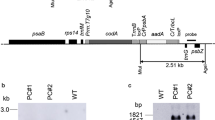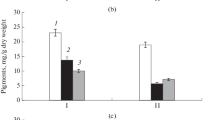Abstract
Genetically engineered rice (Oryza sativa L.) with the ability to synthesize glycinebetaine was established by introducing the codA gene for choline oxidase from the soil bacterium Arthrobacter globiformis. Levels of glycinebetaine were as high as 1 and 5 μmol per gram fresh weight of leaves in two types of transgenic plant in which choline oxidase was targeted to the chloroplasts (ChlCOD plants) and to the cytosol (CytCOD plants), respectively. Although treatment with 0.15 m NaCl inhibited the growth of both wild-type and transgenic plants, the transgenic plants began to grow again at the normal rate after a significantly less time than the wild-type plants after elimination of the salt stress. Inactivation of photosynthesis, used as a measure of cellular damage, indicated that ChlCOD plants were more tolerant than CytCOD plants to photoinhibition under salt stress and low-temperature stress. These results indicated that the subcellular compartmentalization of the biosynthesis of glycinebetaine was a critical element in the efficient enhancement of tolerance to stress in the engineered plants.
Similar content being viewed by others
References
Alia, Hayashi H, Chen THH, Murata N: Transformation with a gene for choline oxidase enhances the cold tolerance of Arabidopsis during germination and early growth. Plant Cell Environ, in press (1998).
Bohnert HJ, Jensen RG: Strategies for engineering water stress tolerance in plants. Trends Biotechnol 14: 89–97 (1996).
Boyer JS: Plant productivity and environment. Science 218: 443–448 (1982).
Chomczynski P, Sacchi N: Single-step method of RNA isolation by acid guanidium thiocyanate-phenol-chloroform extraction. Anal Biochem 162: 156–159 (1987).
Chu CC: The N6 medium and its applications to anther culture of cereal crops. In: Proceedings of the Symposium on Plant Tissue Culture, pp. 43–50. Science Press, Beijing, China (1978).
Church GM, Gilbert W: Genomic sequencing. Proc Natl Acad Sci USA 81: 1991–1995 (1984).
Dekeyser R, Claes B, Marichal M, Montagu MV, Caplan A: Evaluation of selectable markers for rice transformation. Plant Physiol 90: 217–223 (1989).
Deshnium P, Gombos Z, Nishiyama Y, Murata N: The action in vivo of glycinebetaine in the enhancement of tolerance of Synechococcus to low temperature. J Bact 179: 339–344 (1997).
Deshnium P, Los DA, Hayashi H, Mustardy L, Murata N: Transformation of Synechococcus with a gene for choline oxidase enhances tolerance to salt stress. Plant Mol Biol 29: 897–907 (1995).
Epstein E, Norlyn JD, Rush DW, Kingsbury RW, Kelley DB, Cunningham GA, Wrona, AF: Saline culture of crops: a genetic approach. Science 210: 399–404 (1980).
Gabbay-Azaria R, Tel-Or E, Schönfeld M: Glycinebetaine as an osmoregulant and compatible solute in the marine cyanobacterium Spirulina subsulsa. Arch Biochem Biophys 264: 333–339 (1988).
Hanson AD, May AM, Grumet R, Bode J, Jamieson GC, Rhodes D: Betaine synthesis in chenopods: localization in chloroplasts. Proc Natl Acad Sci USA 82: 3678–3682 (1985).
Hayashi H, Alia, Mustardy L, Deshnium P, Ida M, Murata N: Transformation of Arabidopsis thaliana with the codA gene for choline oxidase; accumulation of glycinebetaine and enhanced tolerance to salt and cold stress. Plant J 12: 133–142 (1997).
Hayashi H, Alia, Sakamoto A, Nonaka H, Chen THH, Murata N: Enhanced germination under high-salt conditions of seeds of transgenic Arabidopsis with a bacterial gene (codA) for choline oxidase. J Plant Res, in press (1998).
Hiei Y, Ohta S, Komari T, Kumashiro T: Efficient transformation of rice (Oryza sativa L.) mediated by Agrobacterium and sequence analysis of the boundaries of the T-DNA. Plant J 6: 271–282 (1994).
Holmström KO, Welin B, Mandal A, Kristiansdottir I, Teeri TH, Lamark T, Strøm AR, Palva ET: Production of the Escherichia coli glycinebetaine-aldehyde dehydrogenase, an enzyme required for the synthesis of the osmoprotectant glycine betaine, in transgenic plants. Plant J 6: 749–758 (1994).
Hood EE, Helmer GL, Fraley RT, Clinton M-D: The hypervirulence of Agrobacterium tumefaciens A281 is encoded in a region of pTiBo542 outside of T-DNA. J Bact 168: 1291–1301 (1986).
Igarashi Y, Yoshiba Y, Sanada Y, Yamaguchi-Shinozaki K, Wada K, Shinozaki K: Characterization of the gene for 11-pyrroline-5-carboxylate synthetase and correlation between the expression of the gene and salt tolerance in Oryza sativa L. Plant Mol Biol 33: 857–865 (1997).
Ikuta S, Imamura S, Misaki H, Horiuti Y: Purification and characterization of choline oxidase from Arthrobacter globiformis. J Biochem 82: 1741–1749 (1977).
Incharoensakdi A, Takabe T, Akazawa T: Effect of glycinebetaine on enzyme activity and subunit interaction of ribulose-1,5-bisphosphate carboxylase/oxygenase from Aphanothece halophytica. Plant Physiol 81: 1044–1049 (1986).
Kanavagh TA, Jefferson RA, Bevan MW: Targeting a foreign protein to chloroplasts using fusions to the transit peptide of a chlorophyll a/b protein. Mol Gen Genet 215: 38–45 (1988).
Kishor PBK, Hong Z, Miao GH, Hu CAA, Verma DPS: Overproduction of 11-pyrroline-5-carboxylate synthetase increases proline production and confers osmotolerance in transgenic plants. Plant Physiol 108: 1387–1394 (1995).
Kyozuka J, McElroy D, Hayakawa T, Xie Y, Wu R, Shimamoto K: Light-regulated and cell-specific expression of tomato rbcS-gusA and rice rbcS-gusA fusion genes in transgenic rice. Plant Physiol 102: 991–1000 (1993).
Landfald B, Strøm AR: Choline-glycine betaine pathway confers a high level of osmotic tolerance in Escherichia coli. J Bact 165: 849–855 (1986).
Le Rudulier D, Strøm AR, Dandekar AM, Smith LT, Valentaine RC: Molecular biology of osmoregulation. Science 224: 1064–1068 (1984).
Mae T, Ohira K: The remobilization of nitrogen related to leaf growth and senescence in rice plants (Oryza sativa L.). Plant Cell Physiol 22: 1067–1074 (1981).
McCue KF, Hanson AD: Drought and salt tolerance: towards understanding and application. Trends Biotechnol 8: 358–362 (1990).
Mullet JE, Chua NH: In vitro reconstitution of synthesis, uptake, and assembly of cytoplasmically synthesized chloroplast proteins. Meth Enzymol 97: 502–509 (1983).
Papageorgiou GC, Murata N: The unusually strong stabilizing effects of glycine betaine on the structure and function of the oxygen-evolving photosystem II complex. Photosynth Res 44: 243–252 (1995).
Rathinasabapathi R, Gage DA, Mackill DJ, Hanson AW: Cultivated and wild rices do not accumulate glycinebetaine due to deficiencies in two biosynthetic steps. Crop Sci 33: 534–538 (1993).
Rathinasabapathi B, McCue KF, Gage DA, Hanson AD: Metabolic engineering of glycine betaine synthesis: plant glycinebetaine aldehyde dehydrogenases lacking typical transit peptides are targeted to tobacco chloroplasts where they confer glycinebetaine aldehyde resistance. Planta 193: 155–162 (1994).
Rhodes D, Hanson AD: Quaternary ammonium and tertiary sulfonium compounds in higher plants. Annu Rev Plant Physiol Plant Mol Biol 44: 357–384 (1993).
Rhodes D, Rich PJ, Myers AC, Reuter CC, Jamieson GC: Determination of betaines by fast atom bombardment mass spectrometry. Plant Physiol 84: 781–788 (1987).
Robinson SP, Jones GP: Accumulation of glycinebetaine in chloroplasts provides osmotic adjustment during salt stress. Aust J Plant Physiol 13: 659–668 (1986).
Sakamoto A, Okumura T, Kaminaka H, Sumi K, Tanaka K: Structure and differential responses to abscisic acid of two promoters for the cytosolic copper/zinc-superoxide dismutase genes, SodCc1 and SodCc2, in rice protoplasts. FEBS Lett 358: 62–66 (1995).
Sanada Y, Ueda H, Kuribayashi K, Andoh T, Hayashi F, Tamai N, Wada K: Novel light-dark change of proline levels in Halophyte (Mesembryanthemum crystallium L.) and glycophytes (Hordeum vulgaris L. and Triticum aestivum L.) leaves and roots under salt stress. Plant Cell Physiol 36: 965–970 (1995).
Saneoka H, Nagasaka C, Hahn DT, Yang W-J, Premachandra GS, Joly RJ, Rhodes D: Salt tolerance of glycinebetainedeficient and-containing maize lines. Plant Physiol 107: 631–638 (1995).
Smirnoff N, Cumbes QJ: Hydroxyl radical scavenging activity of compatible solutes. Phytochemistry 28: 1057–1060 (1989).
Tarczynski MC, Jensen RG, Bohnert HJ: Stress protection of transgenic plants by production of the osmolyte mannitol. Science 259: 508–510 (1993).
Yang W-J, Nadolska-Orczyk A, Wood KV, Hahn DT, Rich PJ, Wood AJ, Saneoka H, Premachandra GS, Bonham CC, Rhodes JC, Joly RJ, Samaras Y, Goldbrough PB, Rhodes D: Near-isogenic lines of maize differing for glycinebetaine. Plant Physiol 107: 621–630 (1995).
Author information
Authors and Affiliations
Rights and permissions
About this article
Cite this article
Sakamoto, A., Murata, A.N. Metabolic engineering of rice leading to biosynthesis of glycinebetaine and tolerance to salt and cold. Plant Mol Biol 38, 1011–1019 (1998). https://doi.org/10.1023/A:1006095015717
Issue Date:
DOI: https://doi.org/10.1023/A:1006095015717




